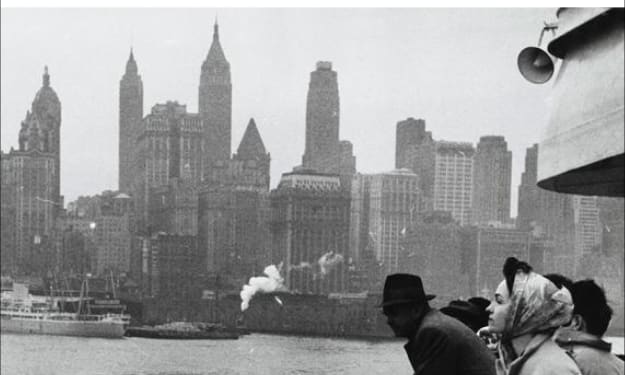A Filmmaker's Guide to: Foreshadowing
Film Studies (Pt.48)

In this chapter of ‘the filmmaker’s guide’ we’re actually going to be learning about literature and film together. I understand that many of you are sitting in university during difficult times and finding it increasingly hard to study and I understand that many of you who are not at university or not planning on it are possibly stuck of what to do, need a break or even need to catch up on learning film before you get to the next level. This guide will be brief but will also contain: new vocabulary, concepts and theories, films to watch and we will be exploring something taboo until now in the ‘filmmaker’s guide’ - academia (abyss opens). Each article will explore a different concept of film, philosophy, literature or bibliography/filmography etc. in order to give you something new to learn each time we see each other. You can use some of the words amongst family and friends to sound clever or you can get back to me (email in bio) and tell me how you’re doing. So, strap in and prepare for the filmmaker’s guide to film studies because it is going to be one wild ride.
Foreshadowing
What is it?
The dictionary defines a 'foreshadowing' as a warning or indication of a future event.
In literature, foreshadowing has always really been quite a popular concept, especially in the modernist era and onwards. But it has also been popular far before the modernist era. Here are some examples you could explore:
- Romeo and Juliet by William Shakespeare
- Harry Potter and the Chamber of Secrets
- Lord of the Rings: The Fellowship of the Ring by J.R.R Tolkien
- Jane Eyre by Charlotte Bronte
- Frankenstein by Mary Shelley
- The Great Gatsby by F. Scott Fitzgerald
- Mrs. Dalloway by Virginia Woolf
- Brideshead Revisited by Evelyn Waugh
- The Bell Jar by Sylvia Plath
- Heart of Darkness by Joseph Conrad
What about in film?

So many different films contain different amounts of foreshadowing. Please do not get foreshadowing confused with a red herring or a Chekhov's gun approach though because they are not in fact, examples of foreshadowing. In fact, foreshadowing only applies to events that are hinted and suggested at in a film without using things such as symbols within the mise-en-scene and/or the things that are excluded.
Here's a watchlist to help you out:
- Memento (2000)
- Psycho (1960)
- The Empire Strikes Back (1980)
- Total Recall (1990)
- Reservoir Dogs (1992)
- Citizen Kane (1941)
- The Shawshank Redemption (1994)
- Pulp Fiction (1994)
- Fight Club (1999)
- A Clockwork Orange (1972)
- The Avengers (2012)
- The Wizard of Oz (1939)
- The Usual Suspects (1995)
- Inception (2010)
- Batman Begins (2005)
All these and so many more contain either large or small aspects of foreshadowing, and I've mixed them up so don't try to guess some sort of pattern!
Of course, there are different kinds of foreshadowing:
Overt Foreshadowing: When some is obviously. Such as: the foreshadowing to the end of the film in "Citizen Kane" (1941) because we already know that Charles Kane dies (it is shown in the very first scene of the film).
Covert Foreshadowing: When it is not obvious but suggested. Such as: in "The Empire Strikes Back" (1980) when Luke sees his own face behind the Vader mask. It is an indirect reference to the relative end to the movie where we find out that Vader is Luke's father.
Dialogue-Based Foreshadowing: When it is spoken by the characters. Such as: "The Usual Suspects" (1995) or in "Memento" (2000). It is said by the characters but we don't notice it until we put it into the context of the end of the film.
Let's now take a look at some further reading that we can apply to this. There are far more examples of foreshadowing in genres such as: horror, thriller and Sci-Fi than there are in genres such as comedy and romance. I would suggest looking for a film which relies heavier on its plot than the identity of its characters.
Further Reading:
- Conrad, J (2020). Heart of Darkness. 2nd ed. UK: Oxford World's Classics
- Shakespeare, W (2000). Romeo and Juliet. UK: Wordsworth Classics
- Shelley, M (2003). Frankenstein: Or, the Modern Prometheus. 2nd ed. UK: Penguin Classics
- Tolkien, J.R.R (1995). The Lord of The Rings. 2nd ed. UK: Harper Collins
- Waugh, E (2012). Brideshead Revisited. 2nd ed. USA: Hachette USA Publishing
- Woolf, V (1993). Mrs. Dalloway. UK: Wordsworth Classics
About the Creator
Annie Kapur
200K+ Reads on Vocal.
English Lecturer
🎓Literature & Writing (B.A)
🎓Film & Writing (M.A)
🎓Secondary English Education (PgDipEd) (QTS)
📍Birmingham, UK






Comments
There are no comments for this story
Be the first to respond and start the conversation.